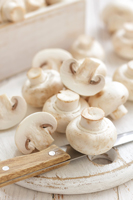 Ancient Medicine for Modern Diseases
Ancient Medicine for Modern Diseases
Fenugreek (Trigonella foenum-graecum), a member of the pea family, is an annual plant that grows from four to 20 inches in height and has pale-yellow flowers. The botanical name for fenugreek means “Greek hay”, since it was used at one time to scent poor quality hay. The plant is native to the Mediterranean region, the Ukraine, India, and China. Today it is cultivated primarily in India, Morocco, Turkey, and China.
Fenugreek pods are about four inches long and contain up to 20 seeds per pod. The flattened seeds are mostly yellowish brown. Occasionally the seeds appear reddish-brown or grayish in color, and they become very hard when dried. They contain a deep diagonal groove that divides the seed into two unequal halves. The seeds are rhombic or flat diamond-shaped, irregularly rounded, about three to five millimeters long and two to three millimeters thick and wide. The seeds are somewhat bitter and spicy, and when chewed they are noticeably sticky. When placed in water, the seeds swell rapidly.
Ancient Uses
The ancient Assyrians cultivated fenugreek centuries before the time of Christ, and dried fenugreek seeds were used medicinally for thousands of years in traditional Indian, Greek, and Arabian medicine. Ancient Egyptians used fenugreek to induce childbirth. The seeds are commonly used in Indian curries, Egyptian bread, and to prepare a coffee substitute in northern Africa.
Fenugreek has a long history of use as a gastrointestinal remedy, as a mild laxative, for dyspepsia, and for the loss of appetite. Others have used it to treat catarrh of the upper respiratory tract. Fenugreek also has a mild antiseptic action.
Externally fenugreek acts as an emollient. It is used externally as a poultice for local inflammation of the skin, boils, leg ulcers, and eczema. The poultice is prepared by soaking the powdered fenugreek seeds in hot water. Today the Chinese use fenugreek to treat abdominal pain, hernia, and edema.
Effect on Blood Glucose and Lipid Levels
Recent studies have investigated the blood cholesterol-lowering and blood glucose-lowering properties of fenugreek seeds, both in normal subjects and in those with diabetes. Significant reductions in total cholesterol, LDL cholesterol, and triglyceride levels, but not HDL cholesterol levels, have been observed in non-insulin-dependent diabetics consuming 25 grams of fenugreek per day. The beneficial effects were sustained over five to six months. With only five grams of fenugreek a day, fasting and postprandial blood glucose levels were significantly reduced in those persons with diabetes. Today fenugreek is recognized as a useful botanical aid in the treatment of persons with diabetes.
For diabetics who are insulin-dependent, a higher level of fenugreek is needed to significantly reduce fasting blood glucose levels, decrease urinary glucose levels, and decrease daily insulin requirements, as well as reduce LDL cholesterol and triglyceride levels. The cholesterol-lowering effect of fenugreek should be considered a valuable feature for the diabetic who usually has elevated blood lipids.
Do Healthy Persons Benefit?
Healthy individuals consuming five grams of fenugreek a day for three months did not experience any change either in their blood lipids or their fasting or postprandial blood sugar levels. However, the chronic ingestion of fenugreek for three weeks did produce an improvement in blood glucose and insulin responses in healthy individuals.
Recently it was observed that consumption of 12 to 18 grams of germinated fenugreek seed powder for 30 days resulted in a significant reduction in blood cholesterol and LDL cholesterol levels, but not HDL cholesterol levels, in 20 adults who had normal cholesterol levels initially. On the other hand, subjects with elevated blood cholesterol levels who consumed powdered fenugreek seeds experienced significant reductions of total and LDL cholesterol and triglyceride levels. While fenugreek is useful for lowering blood cholesterol levels, it does not appear to have any effect on blood clotting.
A Package of Goodies
Fenugreek seeds are rich in carbohydrates, and especially a mucilaginous fiber. This soluble fiber is comprised of galactomannans, similar to properties in that of guar gum. Fenugreek also contains a rich variety of steroid saponins and flavonoids. All of these substances are known to lower blood lipid levels. Fenugreek seeds also contain 4-hydroxyisoleucine, an unusual amino acid that potentiates insulin release from the pancreas. The ability of fenugreek to improve glucose tolerance is further enhanced by its rich content of soluble fiber.
Safety
While no side effects have been reported, diabetic patients should be aware that fenugreek may interfere with other therapies that control blood sugar. Repeated external applications of fenugreek may result in undesirable skin reactions. Furthermore, its use during pregnancy is discouraged.
Conclusions
Powdered fenugreek seeds may serve as an effective supportive therapy in the management of diabetes. Fenugreek also has useful blood lipid-lowering properties for both normal and diabetic subjects. It is also useful for loss of appetite and can be used externally as a poultice for local inflammations.
Remember: Herbal products and dietary supplements can have pharmacological effects, may produce adverse reactions in some people, and could interact with over-the-counter and prescription medications you may take. Discuss with your physician your decision to use any herbal product. Anything mentioned in this article is not intended to diagnose, prescribe, or treat any ailment.
Winston J. Craig, Ph.D., R.D., is a professor of nutrition at Andrews University, Berrien Springs, Michigan.



